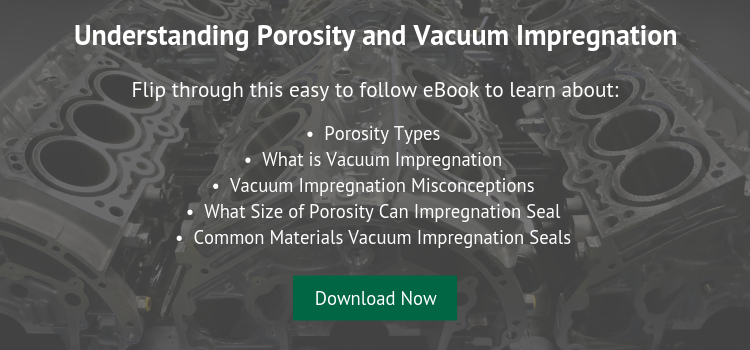In some die casting applications, components must also be pressure-tight to hold pressurized fluid or gases. Companies use vacuum impregnation to meet these requirements by sealing the internal leak paths without impacting any other features of the casting. A commonly asked question is in addition to leak paths, can vacuum impregnation seal cracks?

Understanding Die Casting Cracks
Cracks occur as a result of manufacturing or mishandling. Attempting to seal a crack with any method other than welding is nearly impossible because die casting cracks are dynamic.
The cracks may start sealed, but it is a structural failure that can propagate. During assembly and use, the torque or the applied pressure may cause the cracks to expand. The cured sealant will remain static as the crack expands. As a result, any fluids or gases may seep out of the newly created leak path.
Understanding Die Casting Porosity
Vacuum impregnation seals leaks paths created by interconnected porosity. When the casting is sealed, the vacuum impregnation sealant holds against the casting walls for the life of the casting.
Porosity is formed during the molding process. Gas formation or solidification shrinkage may occur while the metal is in liquid form. Gas related porosity is air trapped in the tool as the metal solidifies. Shrinkage-related porosity is caused by sections of a casting that solidify later than the surrounding parts.
The critical thing to note with either type of porosity is that it occurs during the molding process. The porosity is static. Meaning once it solidifies, the porosity is fixed in size and will not expand or contract. When the part is sealed through vacuum impregnation, the cured sealant will hold against the casting walls for the life of the casting.

Can Vacuum Impregnation Seal Surface Flaws?
A similar question that is also asked: “Can vacuum impregnation seal surface flaws?” Vacuum impregnation sealants are designed to penetrate leak paths inside the casting wall. By design, the sealants are formulated to wash from die casting surfaces.
During the impregnation cycle, the sealant is drawn deep into the leak path by pressure. After the impregnation cycle, water emulsifies the casting, and the sealant washed from all surfaces, machine features, blind holes, and taps.
Only the sealant drawn into the leak path by the force of the vacuum and pressure remains in the casting. A casting with surface flaws before the process will exhibit the same defects after the vacuum impregnation process. However, the leak path below the surface will be sealed.
In Summary
The wide range of die casting parameters creates a limitless array of structural and aesthetic failures. Vacuum impregnation should only be used to seal leak paths created by interconnected porosity.

